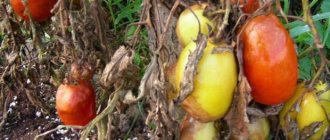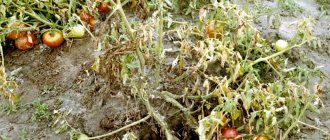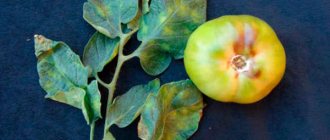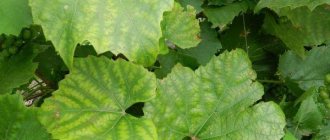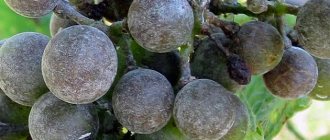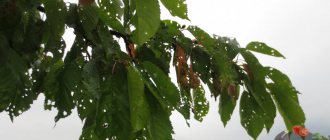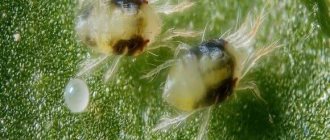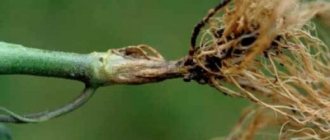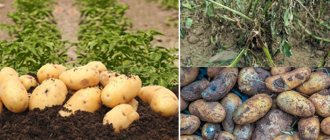What kind of disease is this?
Tomato mosaic is a viral disease. It is very resistant to external influences. Over three hundred different plants can become sources and spreaders of the disease. These include:
- potato;
- beet;
- eggplant;
- pepper;
- spinach;
- tomatoes, etc.
In most cases, mosaic affects varieties grown from seedlings. This is due to the fact that they are exposed to a large number of agricultural practices, which contributes to the spread of the disease.
The causative agent of mosaic in tomatoes is a virus called Tobacco mosaic tobamovirus. The source of this pathogen can be contaminated seeds and even soil.
The disease can spread by getting the juice of an infected plant onto a healthy bush and transmitting the infection by insects, such as:
- cicadas;
- aphid;
- thrips.
Ways to combat the pathogen TMV
Fighting viral infections is a very difficult task. The experience of vegetable growers shows that preventing the disease guarantees the safety of the crop with possible losses, but insignificant. In addition to prevention, visual control, and implementation of developed agricultural technology, there is also the Olin option. It involves breeding tomatoes that are resistant to the virus.
Preparing material for growing tomatoes
- If the set contains only domestic seeds and seeds from unknown producers, then in this case the seedling growing season should begin with a disinfection procedure. To do this, use one of the solutions: 1% trisodium phosphate with a concentration of 1% or 20% hydrochloric acid. After half an hour of treatment in hydrochloric acid or trisodium phosphate, the seeds are thoroughly washed in ordinary tap water and dried.
- Before planting seeds, all seedling pots are disinfected with a KMnO4 (manganese) solution with a concentration of 5%. Formaldehyde solution is also used for disinfection.
- Equipment used in work is subject to mandatory disinfection.
- Seeds of tomatoes that are not resistant to tobacco mosaic are pre-vaccinated, treated with special preparations based on weakened strains of viruses (q-7 or v-69). This procedure is carried out a week after germination.
- Insects that carry the disease can be repelled by placing herbs that repel them in the spaces between the rows of tomato bushes. Such plants include marigolds, calendula, wormwood infusion or pine needles, which also help repel harmful insects. Fresh material is used to prepare solutions. Tomatoes are sprayed with daily infusion every 10 days.
- An infusion of pine needles helps repel insects. Preparing the solution is not difficult: prepare the infusion for 7 days by pouring 10 liters of water over the pine needles. The extract is drained and brought to the original volume - 10 liters. Industrial pine extract is simply diluted in water in a ratio of 1:7.
- Timely and adequate feeding of tomatoes also contributes to the development of bush resistance. Feeding based on preparations containing potassium.
- Temperature conditions and soil containing all the components for normal plant growth are also important factors in obtaining a high-quality tomato crop.
Signs
Symptoms of mosaic in tomatoes can vary. It depends on the degree of infection, the type of disease, and growing conditions.
The main signs of mosaic disease in tomatoes are as follows:
- Withering. This process is observed in the first seven days after infection.
- Loss of elasticity. This symptom is observed when intensive plant growth occurs during a period of significant solar radiation. After a cold snap, the plant recovers.
- Change of color. It can range from pale or colorless to bright yellow and green. In this case, well-defined areas of affected tissue can be seen on vegetables.
- Folding. The leaf blades grow unevenly. This process is more intense in the upper part of the plant.
Other common symptoms of mosaic include deformed leaves. Often their plates are reduced to such a size that the bush can become like a fern. Some parts of it resemble long threads.
Darkening appears inside the fruit. As a rule, it appears near the calyx of the fruit in the form of gray-green areas. Subsequently, these areas grow, including the top of the fruit. Following this, tissue death occurs. This process leads to the appearance of a brown mesh on the fruit. It is clearly visible through the skin of tomatoes.
Spreading
Bushes can become infected:
- through gardening tools, especially pruning scissors and other objects that damage the integrity of leaves and cause wounds;
- through the clothes and shoes of the gardener (the virus can even remain on the hands in the sap of diseased plants);
- for any mechanical damage to the bushes, even minor;
- through the bites of insects that feed on sap - leafhoppers, aphids, thrips;
- due to non-compliance with crop rotation and other violations of agricultural technology.
Causes
The main sources of the virus that causes mosaic in tomatoes:
- infected seeds;
- soil with pathogen spores;
- remains of diseased plants.
The spread of infection occurs in this way:
- While caring for plants. The pathogen can be transmitted through the gardener's tools or clothing.
- Through mechanical damage. Violation of the outer protective shell of the plant leads to the fact that the virus can get inside.
- With the help of insect pests. They are present in large numbers in gardens, spreading the infection quite quickly.
- Due to violations of the rules for carrying out agricultural activities.
A favorable environment for the spread of infection is insufficient lighting of tomatoes. The pathogen is viable in the garden for 22 months.
Soil treatment after tomatoes
The accumulation of the virus in the soil is facilitated by growing crops in the same place. Therefore, the place under the tomatoes in the open ground is changed annually, returning them back only after 3-4 cycles.
Organizing crop rotation in a greenhouse is much more difficult. Here the problem is solved by completely replacing the soil and, if growing tomatoes is combined with cucumbers, changing their places.
In any case, immediately after harvesting, all plant and root residues are raked and burned. The soil is dug deeply, mineral fertilizers are applied according to the requirements of the successor crop.
In spring, the soil is treated with a 2% solution of 40% formaldehyde, shedding the soil until it is completely wet. Then cover with film and leave for 3 days. The same solution is used to treat greenhouse structures.
Varieties, photos
Today, there are two main types of mosaic in tomatoes - tobacco and pepino. They are not significantly different from each other.
Tobacco
This disease accounts for up to 20% of tomato losses worldwide. Main signs of the disease:
- fruit spotting;
- the appearance of yellow spots on the leaves;
- tissue necrosis (death);
- deformation of various parts of plants.
Often, during infection with tobacco mosaic, tomatoes are exposed to other infections. As a result, they begin to lag behind in development. The fruits lose their presentation and decrease in volume.
Pepino
This type of mosaic is the most dangerous. It causes fruit marbling and some other pathological changes such as
- chlorosis;
- nettle-like apexes;
- yellow leaf spot;
- mosaic leaves;
- appearance of brown cups.
Pepino mosaic causes uneven ripening of fruits, cracking, and blistering of leaves. Look at the photos of tomatoes with signs of disease:
Virus biology
There are several strains of the virus with different properties. The disease parasitizes only tomatoes and is abbreviated as ToMV in international classifiers. It is caused by the Tomato mosaic tobamovirus virus. Tobacco mosaic virus on tomatoes affects nightshade and nicotine crops, it is called Tobacco mosaic virus, abbreviated as TMV. In addition, cucumber mosaic can cause similar symptoms.
It has a rod-shaped virion, which dies at a temperature not lower than +93 degrees and an exposure period of at least 10 minutes. It lives in diseased plants for 4-6 weeks, and if the juice is stored under sterile conditions, it lasts up to 5 years.
The pathogen can live in dry leaves of diseased bushes for more than 50 years.
When bacteria get on plants, they penetrate cells and irreversibly change them. The fruits and bushes become covered with spots, dead areas and fibers appear in them, the crop loses its taste and development stops.
If the disease hits a bush that is already infected with the potato virus X, a streak develops - an incurable disease with an even more rapid progression.
How does a viral disease develop and why is it dangerous?
Mosaic can be spread both in greenhouses and in open areas. You can see the first signs of the disease in mid-June. During this period of time, the growth of bushes partially or completely stops.
The process of disease development is as follows:
- Initially, the tops of the bushes become thinner and curl.
- The color of the leaves changes from green to yellow-green.
- Gradually the leaves begin to resemble lace. Spots or necrotic areas may appear on petioles and stems.
- The fruits begin to ripen unevenly and crumble.
- Some tomatoes growing closer to the ground may have brown or yellow areas.
- Browning often spreads to the inside of the tomatoes, which becomes like a mesh.
The danger of mosaic is due to the fact that this disease can spread easily. The disease leads to a significant reduction in the volume of harvested crop. Those fruits that can still be saved do not have a marketable appearance. They may be small in size. On their surface, as a rule, yellow or brown spots are clearly visible.
Principle of disease development
The TMV virus, which has entered the plant, begins to multiply intensively, infecting green plastids containing chlorophyll, which is involved in photosynthesis of the crop. As a result, chlorophylls are destroyed and, as a result, photosynthesis fails, disrupting all important life processes of the plant. The growth and development of the tomato slows down and then the plant dies.
How to fight?
Plants that have been infected with mosaic cannot be saved. Currently, there are no remedies that would completely get rid of this disease. The gardener's task is to strengthen the protective functions of tomatoes.
To combat mosaic, chemical and biological agents are used such as:
Novosil. This remedy is a natural immunostimulant.
Its main functions are stimulating seed germination and strengthening the root system. In addition, the drug destroys some viral diseases. In Novosil it is necessary to soak the seeds. To do this, just 3 drops of the drug per 3 liters of water is enough. The seeds are kept in the solution from evening to morning, then the water is drained. When spraying plants during their intensive growth, you will need 5-15 drops of the product per 3 liters of water. You need to spray once every 2-3 days for a week.
Immunocytophyte. This remedy increases resistance to diseases.
In addition, it stimulates the growth of tomatoes. When treating seeds, you need to prepare a solution using 1 tablet per 1 tablespoon of water. This volume is enough to soak 5 grams of seeds. To treat plants, you need to soak the tablet in 1 tablespoon of water, then add the resulting solution to 2 liters of water. The solution is used to treat plants during the period of active growth from 1 to 5 weeks after planting.
Boric acid. To treat seeds, you need to use 0.5 grams of this product per 1 liter of water. To spray plants, use 1 gram of the drug per 1 liter of water. Spraying is carried out no more than twice a week (in the evening).
- A package of Novosil costs about 1,500 rubles.
- Immunocytophyte can be purchased for 68 rubles.
- Boric acid has a low price - only 8 rubles per package.
Preventive spraying of seedlings
Protective spraying of plants begins while growing seedlings. To do this, 1 liter of whey, low-fat kefir or skim milk is diluted in 10 liters of warm water.
The work is carried out with a home sprayer, completely wetting the leaves and stems of the tomatoes. As a result, a thin film is formed on the surface of plants, which prevents the contact spread of the virus.
The first treatment is carried out the day before picking, the last - the day before planting the seedlings in the ground. The interval between spraying should not exceed 8 days.
5-7 days before planting seedlings, spray with a 0.05% solution of boric acid.
During the season, tomatoes are sprayed 4 times with solutions:
- 0.05% boric acid;
- 0.01% cobalt nitrate;
- 0.01% copper sulfate.
Treatment is carried out in the evening hours with an interval of 15-20 days.
Starting from the age of 14 days, tomatoes are sprayed with adaptogens and biostimulants at intervals of two weeks throughout the season. Preparations: “Heteroauxin”, “Gibbersib”, “Epin”, “Epin extra”.
Prevention measures
Basic methods for preventing mosaic in tomatoes:
- After the first signs of the disease appear, infected plants must be destroyed.
- It is prohibited to collect seeds of diseased tomatoes.
- Crop rotation must be observed.
- When carrying out agricultural activities, it is necessary to treat the tool with alcohol or potassium permanganate.
- After the end of the harvest season, it is necessary to disinfect the walls of the greenhouse.
- Every year in the greenhouse it is necessary to change the top layer of soil 10-15 centimeters thick.
- Smoking is prohibited in the greenhouse.
- The plant must receive a balanced diet.
- Weeds and pests should be constantly controlled.
The above preventive measures do not completely eliminate the disease, but significantly reduce the possibility of its occurrence and spread.
Treatment of tobacco mosaic
This pathogen begins to multiply quickly, so the fight against it must begin immediately after the first symptoms of tobacco mosaic appear. However, this virus is extremely difficult to cope with, so the fight against it can be long.
When the first mosaic-shaped spots appear on the foliage, you should quickly destroy the diseased tomatoes or separate them from healthy ones.
The affected parts of the plants are cut back to a healthy area, and the sections must be disinfected with a weak solution of potassium permanganate or hydrogen peroxide.
When the disease has just begun, the tomato plantings should be treated with Karbofos solution - this procedure will help protect healthy tomato bushes, the drug helps stop the development of pathogenic microflora.
To prepare the solution, 75 g of Karbofos should be diluted in a bucket of water and the tomato plantation should be treated. This spraying is repeated after 1.5 weeks.
Fungicides and other similar agents can also be used to combat TMV. However, these substances are quite toxic, so work with them must be carried out in personal protective equipment and sprayed according to the instructions for use.
At the initial stage of the disease, treating plants with folk remedies that are not toxic is quite effective, for example, spraying tomatoes with a solution of milk with iodine.
To prepare it, you need to pour a liter of milk and 10 drops of iodine into a bucket of water and mix thoroughly. Tomatoes should be sprayed with this solution twice with an interval of 1.5 weeks.
Features of treating seedlings and plants in a greenhouse
In greenhouses, the main reasons for the appearance of TMV are high humidity and poor ventilation. Therefore, as a preventive measure for tobacco mosaic, the greenhouse should be ventilated daily, and the irrigation regime should be observed so as not to over-moisten the soil.
And the methods of combating a disease that has already begun on seedlings or adult tomato bushes are described in detail above.
Soil treatment after tomatoes
After growing tomatoes in garden beds or in greenhouses, the soil should be disinfected, and the structures in greenhouses should also be treated.
After harvesting tomatoes, you should remove all remnants of vegetation from the soil and spill it with a weak solution of potassium permanganate.
In this case, the soil should be moistened by at least 30-40 cm - it is to this depth that the tomato roots go deep into the soil.
If possible, in greenhouses the top layer of soil is removed to a depth of at least 10 cm and replaced with freshly prepared nutritious loose substrate.
You should also wash greenhouse structures, which may also contain the causative agent of this disease, with a solution of potassium permanganate.
Are there tomato varieties resistant to this virus?
Full or partial resistance to mosaic is demonstrated by the following tomato varieties:
- Charisma F1;
- Vologda F1;
- Ural F1;
- Alaska F1;
- Firebird F1.
There are also other varieties that are less susceptible to the disease.
Mosaic in tomatoes is a very common disease that can significantly reduce the volume of the harvest, while worsening the appearance of the fruit. That is why it is very important not only to prevent infection, but also to respond in time to the first manifestations of the disease.
Mosaic Protection Plan
You need to understand that it is almost impossible to cure an infected plant. Therefore, the main task is to prevent the spread of the virus in the area.
Despite the variety of viruses that cause spotting, they all have the same ways of spreading. And accordingly, methods of prevention and protection are similar for different cultures.
To prevent infection, you must adhere to the following action plan:
- carry out pre-sowing seed treatment;
- disinfect the soil before planting crops susceptible to the disease;
- treat the garden with insecticides and acaricides that act on sucking insects (disease carriers);
- treat with preventive fungicides.
Description and symptoms
The causative agent of the disease is the Tomato mosaic tobamovirus virus. Infection with the disease occurs mainly through the soil, from neighboring crops (potatoes, cucumbers). The carriers of mosaics are often insects: mites, aphids, beetles. The virus can be transmitted to plants from infected planting seeds. Once an infection hits tomatoes, defective fruits of an ugly shape and with rotten pulp are formed, and the tomato bushes themselves wither and die over time. The yield is reduced by at least 50%.
The first signs of the disease appear a few days after infection. The main symptom is the appearance of clearly visible inclusions on the leaves, which have a bright border. The spots can be of various shapes and sizes. The leaves begin to stretch and curl. Then the stem and leaves begin to dry out, and the disease quickly attacks neighboring plants. On fruits, the mosaic appears as light green and white spots. The tomato pulp of infected fruits begins to turn black and rot. These tomatoes are no longer suitable for human consumption.
The following factors aggravate the course of the disease:
- high ambient temperature;
- increased air humidity and dampness;
- excess nitrogen fertilizers;
- lack of light.
Mosaic comes in several types: tobacco, ordinary, green and white. Tobacco and common mosaics appear as light spots, but in the first type of disease the spots develop into bumps. Green and white varieties, as the name suggests, form splashes of corresponding colors. Otherwise, the diseases are similar and are equally dangerous for tomatoes.
Methods for detecting pepino mosaic virus
Diagnosis and detection of the virus in both the plant and the seeds are based on serological and molecular tests directly from the plant extract of a tomato sample or after a process of extracting viral RNA from the same extract.
Serological detection
PepMV is identified by ELISA, the rapid ELISA method is commonly used in laboratories due to its simplicity, speed and ability to analyze large numbers of samples, as in the case of seed certification. Another serological method for analyzing samples is also available, immunoprinting ELISA. It involves printing the sample onto a nitrocellulose membrane, followed by serological testing for specific commercial antibodies to the virus. This method has the advantages that there is no need to prepare extracts since the fresh material is immobilized directly on nitrocellulose membranes; it allows simultaneous analysis of a large number of samples.
Molecular detection
There are various molecular procedures used to identify PepMV in plant samples and study molecular variability. Common primers and probes have been described for standard RT-PCR and real-time RT-PCR.
Main PepMV strains
Because PepMV has been found in multiple locations, countries, and species, a number of different strains have been reported. Since 2005, new genotypes have been identified, sharing up to 80% nucleotide sequence identity with the European tomato strain, originating from tomatoes in the USA (US1 and US2) and from tomato seeds from Chile (CH1 and CH2). Comparison of nucleotide sequences suggests that US2 is a recombination of US1 and CH2. There are currently five main PepMV strains known:
- Peruvian (PE) strain originally found on pepino (S. muricatum) and wild nightshade (Solanum spp.);
- EU tomato strain (EU-tom);
- strain US1/CH1;
- strain Chile-2 (CH2);
- PES strain PepMV was recently isolated and described from wild tomato populations in Peru.
Following the initial dominance of the EU genotype in European tomato production, a population shift towards the CH2 genotype has been reported in several European countries.
In the USA and Canada, the EU genotype remains dominant. Mixed infections of multiple genotypes are common and are thought to contribute to PepMV population dynamics. The CH2 genotype is quite different as it displays only 78-80% sequence homology with the EU and LP genotype groups. The US1 genotype has 78% sequence homology with the CH2 genotypes and 82% with the EU/LP genotypes. Mild, moderate, and aggressive isolates share greater than 99% sequence identity between the EU and CH2 genotypes, indicating that subtle differences at the viral genome level may account for significant differences in symptomatology.
Host range of pepino virus
Determining the host range of PepMV has been an important part of the work carried out by several research groups. PepMV causes various symptoms in tomatoes. PepMV has been found to infect several other nightshade crops and test plants such as Datura stramonium, Physalis floridana, Eggplant (Solanum melongena) and Potato (Solanum tuberosum). PepMV is known to infect a relatively wide range of plant hosts representing various families, including both cultivated and wild hosts. Most host species are members of the nightshade family, but some nightshades are not susceptible to systemic infection.
Methods of transmission of pepino
The primary mode of transmission and natural spread of PepMV in the field is mechanical transmission. According to the literature, it is transmitted much more easily and quickly than potato virus X (PVX) and tomato mosaic virus (ToMV). The virus multiplies in large quantities in the cells of host plants and can be transmitted from an infected plant to a healthy one by contact between them, after which the disease progresses along the rows in the greenhouse. However, results from greenhouse experiments indicate that the transmission rate of the virus due to friction with contaminated clothing is less significant than during maintenance activities, mainly during pruning and harvesting. Insect vectors: Aphids (Myzus persicae) and whiteflies (Trialeurodes vaporariorum) are the main vectors of tomato viruses, including PepMV. Several species of bumblebees (B. terrestris, B. canariensis and B. impatiens), which were used as pollinators, were experimentally found to transmit the virus among tomato plants in both Spanish and Canadian greenhouses. Seeds are the source of primary infection and persistence of many viruses. Seed transmission is an ideal starting point for disease spread to the field as infection occurs early in seedling development.
Transmission of the virus between seeds can occur at a low rate (less than 1%) if seeds are not properly cleaned before planting. PepMV persists in the outer seed coat without penetrating the embryo or endosperm. It has been suggested that EC type isolates may be predominant over CH2 type when transmitted through seeds, which may explain the earlier spread of the first isolates in European countries. In the case of tomatoes, grafted seedlings on resistant rootstocks pose a high risk of transmitting viral diseases such as PepMV. Although the virus is easily found in plant roots, it is not found in water or nutrient solutions of hydroponic systems. But in turn, it was found that PepMV can be transmitted to tomato plants irrigated with drainage from PepMV-infected plants in the presence of the fungus Olpidium virulentus with an efficiency of 8%. The high density of zoospores of this fungus in drainage water may increase the transmission of PepMV when irrigating or recirculating a contaminated nutrient solution in a closed hydroponic system.


